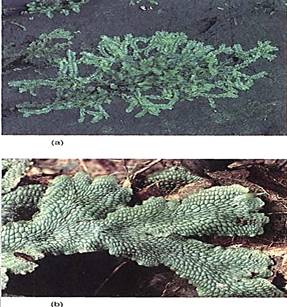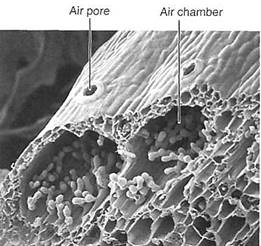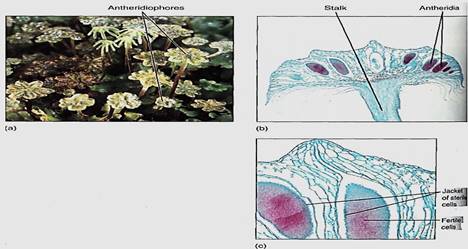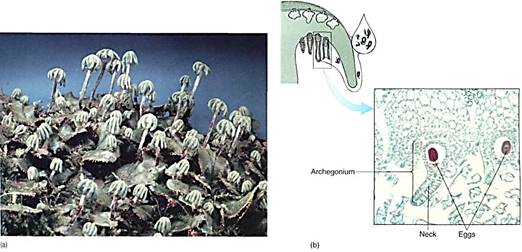


 النبات
النبات
 الحيوان
الحيوان
 الأحياء المجهرية
الأحياء المجهرية
 علم الأمراض
علم الأمراض
 التقانة الإحيائية
التقانة الإحيائية
 التقنية الحيوية المكروبية
التقنية الحيوية المكروبية
 التقنية الحياتية النانوية
التقنية الحياتية النانوية
 علم الأجنة
علم الأجنة
 الأحياء الجزيئي
الأحياء الجزيئي
 علم وظائف الأعضاء
علم وظائف الأعضاء
 الغدد
الغدد
 المضادات الحيوية
المضادات الحيوية|
Read More
Date: 16-11-2016
Date: 17-11-2016
Date: 16-11-2016
|
Division Hepatophyta: Liverworts
Like mosses, liverworts are small plants that have an alternation of heteromorphic generations (Table ). The smallest individuals of Cephaloziella are only 150 pm by 2000 pm. Few species have plants that ever become large, the maximum being approximately 5 by 20 cm in Monoclea. Some species are leafy and greatly resemble mosses (Fig. 1a); others form small, solid, ribbon-like gametophytes similar to fern gametophytes . The sporophyte is even less conspicuous than in mosses and is also completely dependent on the gametophyte.


FIGURE 1 :(a) Leafy liverworts such as this Lophocolea can be very easily confused with mosses. Their distinguishing features (not visible at this low magnification) are their typically lobed leaves, which grow from two apical points, and their basal pouch. Moss leaves are never like this. (L West/Photo Researchers) (b) Thallose liverworts such as this Marchantia have rather thick bodies and are not easily confused with mosses. (G. K. Scott/Photo Researchers)
THE GAMETOPHYTE GENERATION
Hepatics are divided into two basic groups according to the nature of their gametophytes: leafy liverworts (orders Jungermanniales, Haplomitriales, and Takakiales) and Thallose liverworts (Figs. 1 and 2). In both, the gametophyte phase is initiated when spores germinate and establish a small, temporary protonematal phase. Liverwort protonemata are never as extensive or ramified or as long-lived as those of mosses. Instead, after only a few cells are produced, an apical cell is established and growth of the gametophore begins.

FIGURE 2:Life cycle of Marchantia.
The gametophore of leafy liverworts greatly resembles that of a moss—thin leaves on a slender stem (see Fig. 1a). But liverwort leaves typically have two rounded lobes with no midrib and no conducting tissue, whereas moss leaves are pointed and usually have a midrib. Liverwort leaves are arranged in three clearly defined rows, the leaves of two rows being much larger than those of the third. In prostrate liverworts, in which the shoot grows flat against the substrate, the underside row of leaves is reduced and may even be completely suppressed or replaced by rhizoids.
The gametophore stem grows by an apical cell with three, four, or five sides, one uppermost and the others embedded in the stem. Stem tissue is quite simple: All of it is parenchyma, and no thick-walled cells or conducting cells occur in the majority of species. Two genera, Takakia and Haplomitrium, have elongate cells with large plasmodesmata; these are suspected to be involved in long-distance transport. Virtually all cells of liverworts contain characteristic oil bodies.
Thallose liverworts show even less resemblance to mosses. They are not leafy at all but rather flat and ribbon-like or heart-shaped and bilaterally symmetrical. The body is sometimes referred to as a thallus (pl.: thalli), a body without roots, stems, and leaves. At present, "body" is much more commonly used than "thallus." Bodies of thallose liverworts are stratified and tend to be much thicker than those of leafy liverworts and mosses. The side next to the substrate bears unicellular rhizoids, and many cells contain large oil drops. Cells in the side away from the substrate have no oil but are rich in chlorophyll. The cells are loosely arranged as an aerenchyma with large air chambers that open to the exterior by means of large pores (Fig. 3).

FIGURE 3:Although gametophytes of thallose liverworts may become very thick (a few millimeters), they are never solid; rather, they have numerous chambers, and both carbon dioxide and water vapor can diffuse through them easily (X 425). (Biophoto Associates/Science Source/Photo Researchers, Inc.)
Some species are even simpler. Sphaerocarpos texanus is a small, thin ribbon a few cells thick at the center, but the rest of the body is only one cell thick. It has simple rhizoids on the bottom, but no internal air chambers and no scales or other types of vegetative differentiation. These plants are basically as simple as the sea lettuce alga, Viva, or the charophyte, Coleochaete. The liverworts Pallavicinia and Pellia are also this simple.
As in mosses, liverwort gametophores may be either bisexual, producing both antheridia and archegonia, or unisexual, depending on the species. Leafy liverworts may bear their gametangia either mixed with regular leaves or positioned on specialized side branches and surrounded by modified leaves. In thallose species, antheridia and archegonia may be grouped together and surrounded by a tube of chlorophyllous cells. Marchantia is probably the most familiar thallose liverwort because it grows easily on moist soil in greenhouses. Its gametangial production is particularly elaborate. Male gametophores of Marchantia produce an umbrella-shaped outgrowth called an antheridiophore (Fig. 4). It has a stalk several millimeters tall, and dozens of antheridia grow from its upper surface, each surrounded by a rim of sterile cells. Archegoniophores also are stalked, but their apex is a set of radiating fingers that project outward and droop downward; the underside has numerous archegonia (Fig. 5). Archegoniophores occur on separate plants; antheridia and archegonia are not produced by the same gametophyte.

FIGURE 4: (a) These are antheridiophores of Marchantia; as their name indicates, these structures bear (-phore) antheridia. These are gametophytic tissues, and the antheridia are hidden within the upper surface. (Four archegoniophores are also present.) (Runk/Schoenberger from Grant Heilman) (b) Low- magnification view of antheridiophore with antheridia (X 8). (c) Like antheridia in mosses and all other embryophytes, those in liverworts consist of a jacket of sterile cells surrounding fertile cells that differentiate into sperms (X 32).

FIGURE 5 :(a) Archegoniophores of Marchantia are easily recognizable because they have finger-like segments radiating from the stalk. Archegonia are located on the underside (X 3). (Runk/Schoenberger from Grant Heilman) (b) Each archegonium consists of a long, tubular neck and a slightly swollen base, all only one cell thick. Each archegonium contains only one egg (X 160).
If sperm cells are carried to the archegoniophore by raindrop splashing, they swim into the archegonium neck and fertilize the egg. The zygote is retained and grows into a small sporophyte (Fig. 6). Surrounding gametophore tissue expands with it temporarily, forming a protective sheath, and the archegonial neck expands into a calyptra. In Marchantia, sporophytes are so small that each archegoniophore can support many of them.

FIGURE 6:Liverwort sporophytes consist of foot, seta, and capsule (sporangium), but no elaborate set of teeth as in mosses. Instead, the apex breaks into several segments, all of which curl back and release the spores (X 20).
THE SPOROPHYTE GENERATION
little variability exists in the sporophytes of most liverworts, and their basic morphology is like that of mosses. In fundamental structure, however, the two groups are quite distinct. M:st liverwort sporophytes have a foot, seta, and calyptra-covered sporangium, but the seta is extremely delicate, composed of clear, thin-walled cells that collapse quickly (Fig. 6). Many members of Marchantiales have no seta at all. The sporangium is globose and while young is bright green and chlorophyllous, even though it has no stomata. The outer layer of sterile cells is much thinner than in moss sporangia, often only one cell thick. These cells may have nodulose or bandlike thickenings on their walls, a feature mosses never have. The liverwort sporangium lacks a columella, the central mass of sterile cells found in mosses, and dehiscence occurs by means of four longitudinal slits, not by an operculum. Within the sporangium, some cells do not undergo meiosis but rather differentiate into elaters—single, elongate cells with spring-shaped walls. When the sporangium opens, He elaters uncoil, pushing the spores out (Figs. 7 and 8). All liverworts are homosporous.
Strikingly simple sporophytes are produced in Riccia and Ricciocarpus: The zygote grows into a spherical mass within the archegonium of the gametophore body. No toot or seta is formed; instead the inner cells of this mass undergo meiosis and produce spores. As the surrounding gametophore and sporophyte tissues age, die, and decay, the spores are finally liberated.

FIGURE 7:Spores and elaters of the liverwort Haplometrium hookeri. (Courtesy of Sharon Bartholomew-Began, Georgia Southwestern Uni)

FIGURE 8:Thickenings on the walls of elaters are deposited on the interior surface of the wall. As the air dries, the spiral thickenings cause elaters to twist, agitating the surrounding spore mass. Spores are knocked free gradually rather than all falling out simultaneously.



|
|
|
|
تفوقت في الاختبار على الجميع.. فاكهة "خارقة" في عالم التغذية
|
|
|
|
|
|
|
أمين عام أوبك: النفط الخام والغاز الطبيعي "هبة من الله"
|
|
|
|
|
|
|
قسم شؤون المعارف ينظم دورة عن آليات عمل الفهارس الفنية للموسوعات والكتب لملاكاته
|
|
|